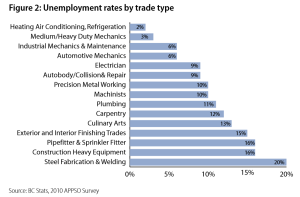The BC government has announced $75 million in funding for trades training programs for the next year. This is because:
“Our goal with the Skills for Jobs Blueprint has been to ensure British Columbians are first in line for jobs in our growing, diverse economy,” said Premier Christy Clark. “And as we move closer to realizing the generational opportunity of LNG, thousands more of those jobs are just around the corner.” (source)
Which makes you think there’s a major skills shortage in BC. Except there isn’t. Not for trades anyway.
Lets take a look at the 2010 numbers for unemployment (FYI the 2014 numbers are slightly better with unemployment down about 1-1.5% for trades from what I can find).
Yes, for many of the trades it’s a great time to be working. With the provincial unemployment rate at 7% having four of the biggest trades being under that is amazing. However the overall Trades unemployment rate (pdf) was 11%, so still you see some great trades, many of which pay well doing better than that.
Ok, now lets talk Health Care and Social Assistance. These are professions for which you usually have a directed degree or post degree program similar to the trades (though they’re usually two to four years longer).
The unemployment rate for Health Care & Social Assistance (including hospital employees, resident care employees, ambulance services, and social assistance) over the last five years has varied between 1.7% and 2.2%. Yep. A much better category than Trades to be in, and they generally pay as much as the trades (significantly more if your position requires an advanced degree)
Well what about other skilled degree programs? Education for example is between 2.9% and 4.8%. Again much better. Legal Services, Architectural, Engineering and Design Services, Computer System Design Services are between 2.7% and 4.9%
If you’re looking to keep unemployment rates low it seems to me the best option is to encourage people to go into fields where they don’t have a 20% unemployment rate (I’m looking at you welding).
So lets look at what our premier said:
“And as we move closer to realizing the generational opportunity of LNG, thousands more of those jobs are just around the corner.”
And now lets contrast that with what was in the governments own Labour Market projections:
It is projected that the trades occupations employment growth will average 1.2 percent over the next 10 years. By comparison, total provincial occupation growth will average 1.4 percent over the same projection period (0.2 percentage points more than trades occupations).
I’m not saying that investment in the trades is a bad thing, it’s a great thing. A lot of my Adult Upgrading students are interested in the trades and this funding benefits them. But lets not forget the programs that have lower unemployment rates.
And remember that Education, Health, and Social Services are three areas where the government directly pays the industry. So an increase in funding for them coupled by an increase in education and employment means more people making money, spending it, and paying taxes.

Leave a Reply